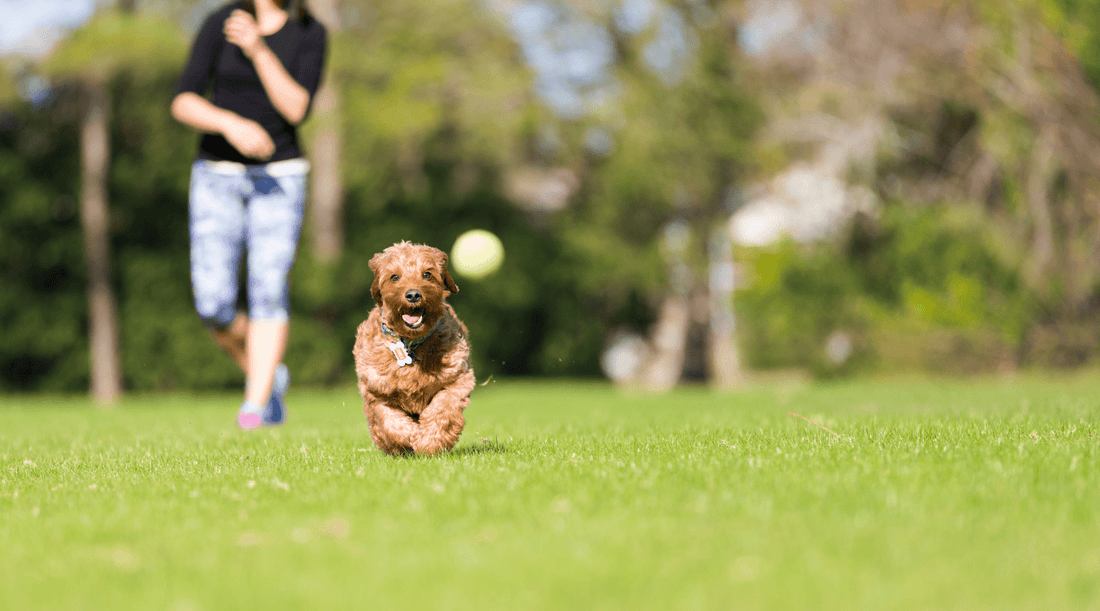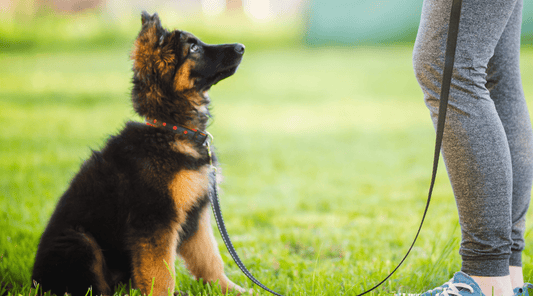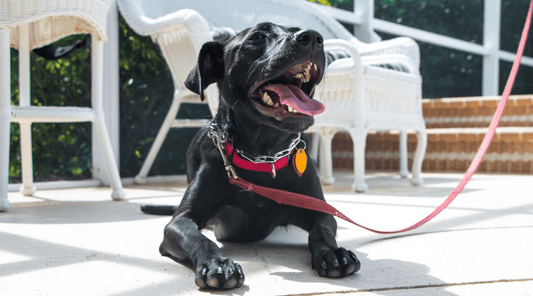
How to Teach a Dog to Fetch: When Bruno Refused to Drop the Shoe
Dawn Miller Apr 26, 20255 Minute ReadPixie loves to fetch. Bruno? He thinks fetch means “I bring it halfway and then we wrestle for it.” Learning how to teach a dog to fetch isn't as easy as throwing an object for them to bring back. But it's also not hard for most dogs to get with positive reinforcement dog training.
So last Wednesday, when my neighbor’s grandson brought over a tennis ball and asked if I could teach his dog to play fetch, I knew we were in for a ride.
Would his eager young pup be a Pixie—with her flawless record? Or Bruno saying, let's play tug of war instead today.
Why Fetch Is One of the Best Fun Games for Dogs
There's a reason fetch is synonymous with dogs.
This game gives them a full-body and cardio workout in a matter of minutes a day. It keeps their reflexes and minds sharp. It can make high-energy dogs manageable and reactive dogs less likely to bark at and chase everything.
It's also mentally stimulating, as dogs learn to watch for (and listen to) cues from you about when you'll throw and where.
Plus, chasing and retrieving mimic behaviors dogs evolved to do. So it’s a great way to satisfy their hunting instinct in a safe, structured way.
How to Train a Dog to Fetch
The truth is that not every dog gets it right away. And some dogs, like Bruno, forget how to play sometimes. That’s where you come in.
Step 1: Choose the Right Toy
You thought I was going to say dog bone, didn't you? Nope. You need a toy like a ball or flying disc. Some dogs prefer squeaky toys. So, keep your mind open and get ready to throw.
Test a few. If it fits easily in their mouth and they show interest in it, you’ve got a winner.
Step 2: Choose the Right Dog Treats
Yes, for some dogs, the toy is its own reward. But you'll need treats to teach them to bring it back to you. Choose high-value dog treats that are irresistible, single-ingredient, and nutritious. We play fetch with beef lung bites from K9 Connoisseur as the tasty reward.
Step 3: Teach "Come" and "Drop It" First
If you haven't already, it's helpful to teach them "come" and "drop it" before you teach a dog to fetch. These commands will let you communicate the complex actions required to play this game.
I discuss how to teach a dog to come to you here. And how to teach drop it here.
Step 4: Get Excited About the Toy
Wave the object around and act like it's the "bestest thing in the whole wide world". Depending on what it is, bounce it. Make it squeak. Swish it in the air. Bring the energy. The more exciting you act, the more likely your dog will mirror your enthusiasm.
Oh, didn't I tell you, this is a mini-workout for you too!
Pixie is all in the moment. I start hopping around, and I swear she thinks I have a live squirrel for her. Then Bruno's like, “Lady, that’s clearly just a Frisbee™, but you do you.”
Step 5: Encourage Chase
Toss the toy just a few feet and say "fetch". When they go after it, praise like they've just negotiated world peace: “Good dog! Yes!” Use your happy voice.
Yes, even if the neighbors can hear you. They'll get used to it—and you can tone it down once your dog gets it if you want.
If they grab it—awesome! Praise!
If not, walk past them without a word and go get it yourself. Toss it again. The goal is to show them it’s a game. When they pick up, they get the praise reward.
Some dogs need a little practice before it clicks. Others? They’re already halfway down the trail before you say “fetch.”
Step 6: Reward the Pick-Up First
As soon as your dog grabs the toy, toss them a Dog Treat and give verbal praise. I carry beef lung training treats in a treat pouch to be ready for rewards.
Step 7: Teach the Return
Now, the hard part. Left to their own devices, dogs will freestyle this—shaking it, tossing it to the ground and pawing it, etc.
Others will bring it halfway and drop it—for some reason I really don't understand. A few will grab it and run off like they just robbed a bank.
You need to teach the dog that fetching includes bringing it back.
Here’s how to fix it:
- Back up slowly as they come toward you.
- Call them excitedly: “Come!” If you have taught them hand signals for come now's the time to use that too. The most common "come" hand signal for dogs is bring open palm from your waist to shoulder.
- When they get close, offer a dog treat as a trade for the toy. Dropping it at your feet, is a rewardable action as well as letting you take it easily from their mouth. You may prefer one and can refine the behavior later.
- If needed, say “drop it” and reward the moment they do. Again, it helps to teach the basic command "drop it". This just shows how teaching your dog basic commands allows you to build on those skills.
Repeat. Repeat. Repeat. Some dogs take longer than others to get it. If your dog just doesn't seem to get it after 3-5 minutes, switch to something they know, like "sit." Reward them. End the training. Try again tomorrow. Ending on a high note will make them more willing to try again.
Bruno only learned to bring the toy all the way back when he realized I was handing out treats every single time. He’s no fool.
Step 8: Practice Your Timing
Like all dog training, success comes down to timing. You’ve got a tiny window between “Yes! You did the thing!” and “Wait, was that right?”
So praise the moment they pick up the toy. Reward with a healthy dog treat as soon as they bring it back. Over time, you’ll fade the treats and rely on praise, belly rubs, or another toss as the reward.
But early on? Bring the beef.
Troubleshooting When You Teach a Dog to Play Fetch
What If My Dog Won’t Chase the Toy?
Try a toy that smells like food or squeaks. You can also try dragging it around like prey (on a rope or string) to get their attention.
What If My Dog Won’t Bring It Back?
Start with tug games. Teach “drop it” first. Practice recalls (come command) separately using dog treats as motivation. Once those are solid, combine them with fetch.
What If My Dog Runs Away With It?
Play in a confined area. Reduce distractions. Starting a twice-weekly dog bone session can improve focus, making dogs more trainable. I give them single-ingredient marrow-filled dog bones to ease anxiety, alleviate boredom, and improve trainability.
Don’t Forget to Rest and Refuel
Fetching works muscles and brains. So after a session, offer your pup a long-lasting dog bone to chew on while they cool down.
It helps with dog health, satisfies their need to chew, and gives you a break.
It's time to teach your dog some skills. Join the 7-Day Dog Training Challenge to see how far you and your pup can go.
Available On:


Disclosure: This article may contain affiliate links, which means we may earn a small commission if you make a purchase through these links—at no extra cost to you. We only recommend products we trust and believe will benefit you and your K9.



